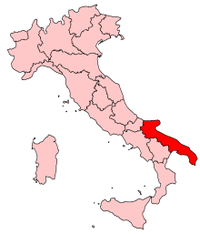- Sacra Corona Unita
-
Sacra Corona Unita 
Map highlighting the location of Puglia in ItalyIn Apulia, Italy Years active 1970s–present Territory Italy (north, central and south), France, Germany, Spain, Belgium, Eastern Europe, United States, Canada Ethnicity Italian, Apulian Membership 2500+ Criminal activities Cigarette smuggling, arms trafficking, drug trafficking, kidnapping, extortion, fraud, illegal immigration, loansharking, money laundering, murder, people smuggling, political corruption, pornography, and illegal gambling Allies Sicilian Mafia, 'Ndrangheta, Albanian Mafia, Serbian Mafia, Colombian Drug Cartel, Russian Mafia, Chinese Triads, Japanese Yakuza Sacra Corona Unita, (SCU) or United Sacred Crown, is a Mafia-like criminal organization from Apulia (in Italian Puglia) region in Southern Italy, and is especially active in the areas of Brindisi, Lecce and Taranto .
Contents
Background and activities
The SCU was originally founded in the late 1970s as the Nuova Grande Camorra Pugliese (current Società foggiana) by Camorra boss Raffaele Cutolo, who wanted to expand his operations into Puglia. However a few years later with the downfall of Cutolo the organization began operating alone under the leadership of Giuseppe Rogoli. Under his leadership the SCU mixed Pugliese interests and opportunities with 'Ndrangheta and Camorra traditions. Originally preying on Puglia's substantial wine and olive oil industries, the group moved into fraud, gunrunning and drug trafficking and made alliances with international criminal organizations such as the Russian and Albanian mafias, Colombian drug cartels, Chinese Triads, and Japanese Yakuza.
The SCU is made up of three distinct groupings or levels. Members can 'graduate' from one level to the next by going through riti battesimali (baptismal rites). The religious symbolism is probably left over from the SCU's association with the Camorra.
The lowest level, the Società Minore, is made up of lower-level criminals who do street-level activities. Members start out as picciotti and go through a 40-day trial to ensure they are suitable for criminal work and are not associated with the police. They are then inducted into the next phase of the level, the manovalanza, or worker. The candidate must also swear an oath of devotion to SCU.
The second level, the Società Maggiore, is made up of two positions. The Lo Sgarro position is given only to members who have killed at least three people for SCU, and from now on members cannot leave, on pain of death. Members can now form their own crew of picciotti, known as a filiale. Upon indoctrination into the La Santa position the member is given a firearm (to symbolically use on oneself upon failing SCU), a cyanide pill, cotton (representing Monte Bianco, which is considered sacred), a lemon (treating the wounds of one's comrades), a needle to puncture the index finger of the right hand, handkerchiefs (representing purity of spirit) and a spartenza (a gift of some sort, usually cigarettes). [1]
The final level is the Società Segreta, the core of the organization where key decisions are made.
The Sacra Corona Unita consists of about 50 clans with approximately 2,000 members and specializes in smuggling cigarettes, drugs, arms, and people. The Sacra Corona Unita collects payoffs from other criminal groups for landing rights on the southeast coast of Italy. This territory is a natural gateway for smuggling to and from post-Communist countries such as Croatia, Serbia, and Albania. Very few SCU members have been identified in the United States, however there are some links to individuals in Illinois, Florida and possibly New York. The Sacra Corona Unita is also involved in money laundering, extortion, and political corruption.
With the decreasing importance of the Adriatic corridor as a smuggling canal (thanks to the normalization of the Balkans area) and a series of successful police and judicial operations against it in recent years the Sacra Corona Unita has been reduced to a fraction of its former power, which peaked around the mid-1990s.
Symbolism
Informer Cosimo Capodieci said the SCU used "the Corona because it resembles a crown, meaning the rosary typically used in Church in order to carry out the functions of Jesus Christ and the cross... Unita because it was necessary to be connected to one another, similar to the rings of a chain."[2]
Rivals
The internal difficulties of the SCU aided the birth of antagonistic criminal groups such as:
- Remo Lecce Libera: formed by some leading criminal figures from Lecce, who claim to be independent from any criminal group other than the 'Ndrangheta. The term Remo indicates Remo Morello, a criminal from the Salento area, killed by criminals from the Campania region because he opposed any external interference;
- Nuova Famiglia Salentina: formed in 1986 by De Matteis Pantaleo, from Lecce and stemming from the Famiglia Salentina Libera born in the early 1980s as an autonomous criminal movement in the Salento area with no links with extra-regional Mafia expressions;
- Rosa dei Venti: formed in 1990 by De Tommasi in the Lecce prison, following an internal division in the SCU.[3]
See also
Notes
- ^ http://americanmafia.com/Feature_Articles_337.html AmericanMafia - The Fourth Mafia: La Sacra Corona Unita
- ^ as quoted in The Global Mafia, pg 69.
- ^ Le criminalità organizzate nell'Italia meridionale continentale: camorra, 'ndrangheta, sacra corona unita Carlo Alfiero, Generale di Brigata - Comandante Scuola Ufficiali CC
Organized crime groups in Europe National groups Albanian mafia • British Firms • Belgian mafia • Bulgarian mafia • Chechen mafia • Corsican mafia (Unione Corse) • Estonian mafia • Macedonian Mafia • Montenegrin Mafia • Polish Mob • Russian Mafia (Thief in law) • Serbian mafia • Slovak mafiaItaly ActiveCamorra • Mala del Brenta • 'Ndrangheta • Sacra Corona Unita • Sicilian Mafia (Cosa Nostra) • StiddaInactiveCategories:- History of the Sacra Corona Unita
- Organized crime groups in Italy
- Organized crime-related lists
- Secret societies related to organized crime
- Transnational organized crime
Wikimedia Foundation. 2010.
